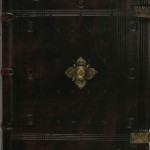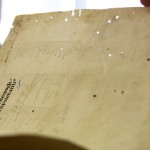Most people would agree that libraries are full of stories. Each year when our local 3rd graders visit the Rakow Research Library, I ask them what they think of when they hear the word “library.” “Books!” is invariably the first answer (and sometimes the second, third, and fourth answer too). And what do you find in books? Stories, of course.
But, as the students discover, libraries have more stories than are found within books. Libraries also tell the stories of the people who owned and created an item in their collections and the story of what happened to that item before it arrived at their doors. Our collection spans 865 years of history; the materials we house certainly haven’t spent all that time sitting neatly on our shelves.
The Rakow Library, which opened with the Museum in 1951, is 64 years old (801 years younger than our oldest item). We started out with around 500 items in our collections; we now have about 500,000. Each year we add thousands of books, journals, videos, and special collections to our physical and virtual shelves, some brand new and some decades or centuries old. We work hard to organize and preserve those materials so people can use them for many years to come. Part of that process involves investigating and recording information about the history of the items that come through our doors.
We have selected a variety of materials from our collection for our upcoming Library exhibition, Selections from the Rakow Library, on display March 19, 2015 – May 17, 2015. This exhibition will showcase some of the many formats our Library collects, including books, photographs, design drawings, sketchbooks, postage stamps, trade catalogs, stock certificates, letters, and notebooks.
Each of these items has a story (or stories) of its own. Some were owned by kings of countries and titans of the glass business. Others were created by artists and performers. Some went through floods and were gnawed on by bookworms, and others were kept safe and secret for generations.
Often the events in an item’s life leave physical traces. In the case of De proprietatibus rerum (“On the Properties of Things”), a rare book published in the familiar year of 1492, the binding and pages contain hints of the book’s past. One event we know about without a doubt is the flood of 1972. Flood waters damaged large portions of the Museum and Library collections, including many of our rare books. A recent Library exhibition explored the Museum’s recovery efforts, which included bringing in conservation expert Carolyn Horton to repair Library materials. In the case of De proprietatibus rerum, she remove the original binding, preserved it in Mylar, and rebound the book in a new cover using the original brass fittings. Horton left notes in the back of each book she conserved, making sure future users would know the condition she found the book in and how she treated it.
- Preservation cover with original brass fittings for Bartholomeus Anglicus’s De proprietatibus rerum.
- The small, round holes on this page are evidence of bookworms.
But the flood was hardly the first entity De proprietatibus rerum encountered. As we learned last year, the book encountered another sort of disaster much earlier, perhaps even centuries prior to the flood. You might notice the tiny holes in the page pictured above – those holes are evidence of the insects popularly known as bookworms. These pests seek out the protein and starch found in the bindings and pages of books. In the case of De proprietatibus rerum, one bug was tenacious enough to eat through all 200 or so pages. The original binding and first pages are riddled with holes, and remind us that humans aren’t the only creatures to enjoy books.
Come explore the Selections from the Rakow Library exhibition at the Rakow Library and see what stories you can discover in our collections.
The Rakow Research Library is open to the public 9am to 5pm every day. We encourage everyone to explore our collections in person or online. If you have questions or need help with your research, please use our Ask a Glass Question service.



